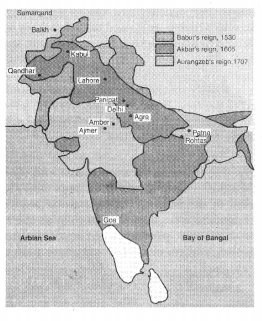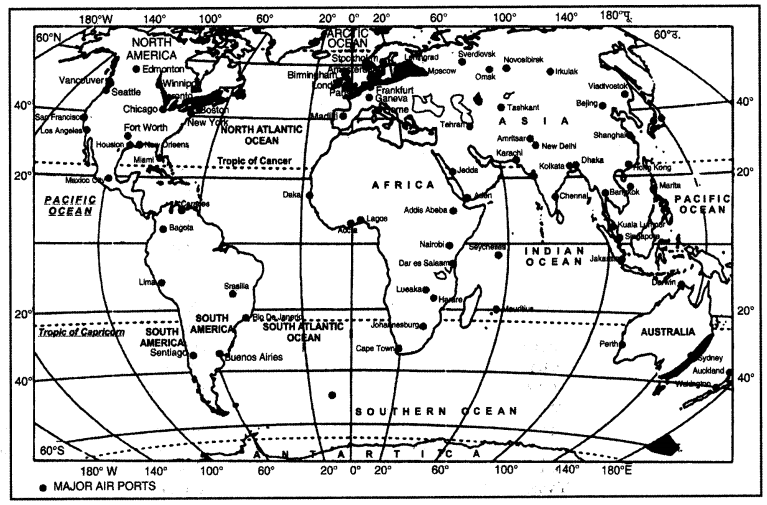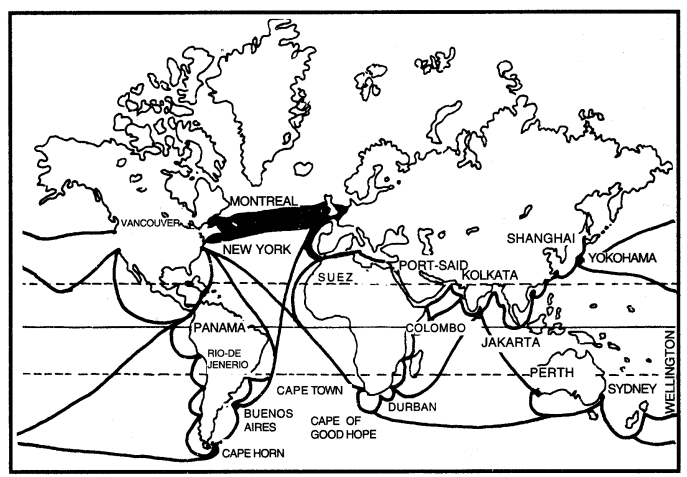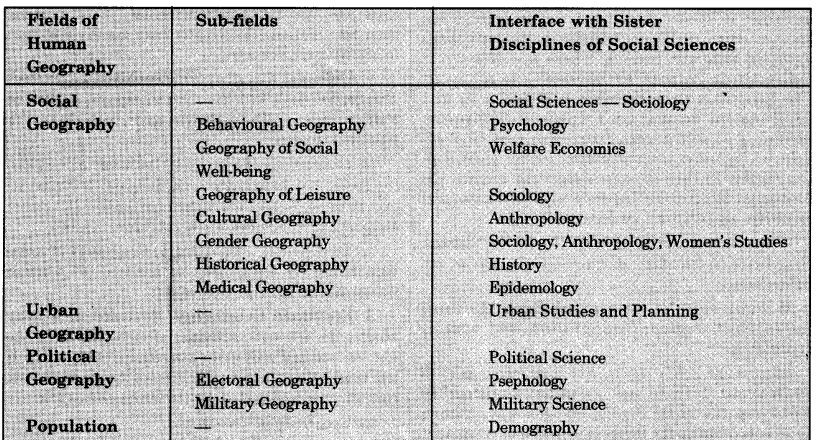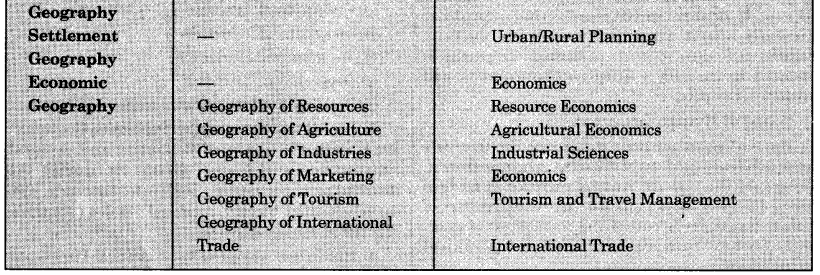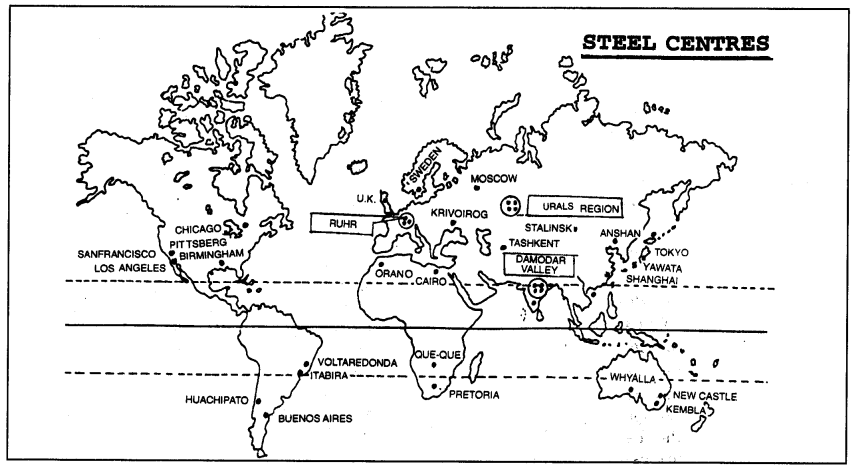Here we are providing Class 12 Geography Important Extra Questions and Answers Chapter 9 International Trade. Geography Class 12 Important Questions are the best resource for students which helps in class 12 board exams.
Class 12 Geography Chapter 9 Important Extra Questions International Trade
International Trade Important Extra Questions Very Short Answer Type
Question 1.
To which category of activities does trade belong ?
Answer:
Tertiary.
Question 2.
Name two types of trade.
Answer:
International and national.
Question 3.
What was the initial form of trade ?
Answer:
Barter system.
Question 4.
What does word ‘Salary’ mean ?
Answer:
It comes from the Latin word Solarium meaning payment by salt which was rare and expensive.
Question 5.
What was the length of Silk Route ?
Answer:
It was 6000 km long form Rome to China.
Question 6.
When was slave trade abolished in USA ?
Answer:
In 1808.
Question 7.
Name three products which are exported from tropical regions.
Answer:
Bananas, Rubber and Cocoa.
Question 8.
Name three aspects of international trade.
Answer:
Volume, sectoral composition and direction of trade.
Question 9.
What is positive balance of trade ? (C.B.S.E. 2013)
Answer:
If the value of exports is more than that of imports.
Question 10.
What is negative balance of trade ?
Answer:
If the value of imports is more than that of exports.
Question 11.
Expand MFN.
Answer:
Most Favoured Nation.
Question 12.
When was WTO formed ?
Answer:
On 1st January, 1995.
Question 13.
Expand WTO.
Answer:
World Trade Organisation.
Question 14.
What do you mean by GATT ?
Answer:
General Agreement on Trade and Tariffs.
Question 15.
Expand OPEC.
Answer:
Organisation of Petroleum Exporting Countries.
Question 16.
Mention any two problems of barter system. (Delhi 2019)
Answer:
(i) Double coincidence of wants.
(ii) Lack of information.
International Trade Important Extra Questions Short Answer Type
Question 1.
What do you mean by trade ?
Answer:
The term trade simply means the voluntary exchange of goods and services. Trade is one of the most important human (economic) activities. It refers to the movement of goods and services from areas of surplus to areas of deficit. In simple words, it is exchange of products or marketing between nations and regions. For both the parties, trade is mutually beneficial.
Question 2.
What is barter system ? (C.B.S.E. 2013)
Answer:
The initial form of trade in primitive societies was the barter system. In this, direct exchange of goods takes place. Two parties sell and purchase their products by exchanging these.
Question 3.
Where is barter system practised in India ?
Answer:
Every January, after the harvest season, Jon Beel Mela takes place in Jagirod, 35 km away from Guwahati. It is, the only fair in India where barter system is alive among tribes and communities.
Question 4.
Describe the different forms of art and craft developed in certain countries.
Answer:
(i) China produces the finest porcelains and brocades.
(ii) Iran is famous for carpets.
(iii) North Africa is famous for leather work.
(iv) Indonesian batik cloth is valuable.
Question 5.
Name the major items of merchandise which are traded over the world.
Answer:
The major items of merchandise traded over the world include the following :
- machinary and equipment
- fuel, minerals
- office and telecom equipment
- chemicals and automobiles
- iron and steel
- clothing and utensils.
Question 6.
What are Oil ports ? Give examples.
Answer:
Oil Ports. These ports deal in the processing and shipping of oil. Some of these are tanker ports and some are refinery ports. Maracaibo in Venezuela, Esskhira in Tunisia, Tripoli in Lebanon are tanker ports. Abadan on the Gulf of Persia is a refinery port.
Question 7.
What are Naval ports ? What [Mill are their functions ? Give two examples from India. (C.B.S.E. 2013)
Answer:
Naval Ports. These are the ports which have only strategic importance. These ports serve the warships and have repair workshops for them. Kochi and Karwar are the examples of such ports in India.
Question 8.
What are Entrepot ports ? Give one example.
Answer:
Entrepot Ports. These are collection centers where the goods are brought from different countries for export. Singapore is an entrepot for Asia. Rotterdam for Europe, and Copenhagen for the Baltic region.
Question 9.
Distinguish between International and National Trade.
Answer:
Trade may be classified into two levels : international and national. International trade is the exchange of goods and services among countries across national boundaries. Countries need to trade to obtain commodities they cannot produce themselves or they can purchase elsewhere at a lower cost. When trade occurs between different states of a country, it is called national trade.
Question 10.
What do you know about the Silk Route?
Answer:
The Silk Route is an early example of long distance trade connecting Rome to China— along 6000 km route, and the trade transported Chinese silk, Roman wool and precious metals and many other high value commodities from intermediate points in India, Persia and Central Asia.
Question 11.
Distinguish between Bilateral trade and Multi-lateral trade. (C.B.S.E. 2013-2014)
Answer:
(i) Bilateral trade. Bilateral trade is done by two countries with each other. They enter into an agreement to trade specified commodities against them. A country may import raw materials against export of manufactured goods.
(ii) Multi-lateral trade. Multilateral trade is conducted with many trading countries. The same country can trade with a number of countries. Some countries are granted the status of most favoured nation.
Question 12.
What is free trade ? What are its effects ? (C.B.S.E. 2013)
Or
Mention any two ill effects of free trade and economic globalization. (Delhi 2019)
Answer:
The act of opening up economies for trading is known as free trade or trade liberalisation. This is done by bringing down trade barriers like tariffs. It allows goods and services from anywhere to compete with domestic products.
Effects. It adversely affects the economies of developing countries. They impose unfavourable conditions. Free trade should not let rich countries enter the markets. They should allow the developed countries to keep their own markets protected from foreign products. Free trade does not make the lives of ordinary people more prosperous. It is actually widening the gap between the rich and the poor by making rich countries richer.
Question 13.
How will increasing international trade affect global environment ?
Answer:
Global trade affects many aspects of life :
(i) It can impact everything from the environment to health and well being of the people around the world.
(ii) As countries compete to trade more, production and the use of natural resources spiral up, resources get used up faster than they can be replenished.
(iii) The marine life is also depleting fast, forests are being cut down and river basins sold off to private drinking water companies.
(iv) Multinational Corporations trading in oil, gas mining, pharmaceuticals and agri-business keep expanding their operations at all costs creating more pollutions
(v) Their mode of work does not follow the norms of sustainable development. If organisations are geared only towards profit making, and environmental and health concerns are not addressed, then it could lead to serious implications in the future.
Question 14.
International trade is beneficial to [ both exporting and importing countries.Discuss.
Answer:
The exchange of surplus goods between different countries is called international trade. The countries with surplus production export the particular goods. These countries benefit by earning foreign exchange. Some densely populated countries have to import goods to meet the demand.
These countries depend on the import of raw materials for their economic and industrial development. The economy of Sri Lanka depends upon export of tea. The industrial development of Japan depends upon the import of raw materials.
Question 15.
‘International trade is known as the barometer of economic development of a country.’Why ?
Or
“In modern times international trade is the basis of the world economy.” Support the statment with examples. (C.B.S.E.Outside Delhi 2017)
Answer:
International trade is the index of economic development of a country. International trade has increased manifold during the last forty years. This increase has been due to developed technology and the rapid means of transportation.
Now-a-days, the developed countries are major trading countries. On the other hand, developing countries have a low level of trade. The industrialized countries import raw materials and- export manufactured goods to earn foreign exchange. It helps to raise the standard of living of people of these countries. Thus the per capita trade represents the economic development of a country. But in countries of large population, the per capita trade is low despite the fact that the total amount of trade is high.
Question 16.
Why are the ports called ‘gateway^ of international trade’ ?
Answer:
Port. A port is a place on the coast which provides facilities such as docking, loading and unloading and storage facilities of cargo. A port handles the import and export trade of a country. A port is connected with its hinterland by rail-road transport. These land routes are used to transport the goods to a port from where these goods are exported through ocean routes.
Similarly, imports are sent to the hinterland of a port. In fact, a port acts as a point of entry for the goods received from foreign countries and a point of exit for the goods produced in its hinterland. Therefore, a port is called a gateway of international trade. For example, Kolkata is a commercial gateway for its hinterland comprising states of West Bengal, Bihar, Assam.
Question 17.
Name the geographical conditions necessary for the development of an ideal port.
Answer:
A port handles the import-export trade of a country. It acts as a commercial gateway for its hinterland. The following conditions favour the development of an ideal port:
- Presence of protected Harbour.
- A deep water natural harbour is required.
- Sufficient space is required for docking facilities.
- The hinterland should be well connected with the port by rail-road routes.
- A rich hinterland is required.
- Favourable climate so that the port remains open throughout the year.
- Fuel facilities should be available.
Question 18.
What is the role of ‘World Trade Organisations’ as an international organisation ? Why has the World Trade Organisation been criticised by some countries? Explain the role of World Trade Organisation. (C.B.S.E. 2014)
Answer:
Role of WTO :
- It formulates the global rules of trade between countries.
- It resolves disputes between its member nations.
- It covers trade in services particularly banking and communication facilities.
Criticism :
- Some countries criticise WTO due to effects of free trade.
- It widens the gap between the rich and poor nations.
- WTO focuses on the commercial interests.
- It ignores the issues of environmental pollution, health, right of workers and child labour
Question 19.
Distinguish between Barter trade and Monetary trade.
Answer:
| Barter Trade | Monetary Trade |
| 1. It is the earliest form of local trade.
2. Barter system means the exchange of goods without the use of money. 3. It is limited in nature and has the difficulty of rate of exchange of goods. |
1. It is modern system of international trade.
2. Monetary system means the exchange of goods where one item is exchanged for the other. 3. It is used for trade of a number of commodities from different countries. |
Question 20.
Distinguish between National trade and International trade.
Answer:
| National Trade | International Trade |
| 1. National trade means the wholesale trade on a large scale within the boundaries of a country’.
2. Tt is also known as internal trade. 3. National trade depends upon the extent of a country. |
1. International trade means exchange of goods, services, capital across the national boundaries.
2. It is also known as foreign trade. 3. Internationa trade depends upon the surplus production and purchasing power |
Question 21.
Distinguish between favourable balance of trade and unfavourable balance of trade.
Or
What is meant by balance of trade?
Answer:
| Favourable balance | Unfavourable balance |
| 1. When there is an excess of exports, it is called a favourable balance of trade.
2. In 1976-77 in India, the imports were of value = 5073 crore rupees while exports were of value = 5142 crore rupees. Balance of trade was + 69 crore rupees. 3. It helps to strengthen the economy of a country. |
1. When there is an excess of imports, it is called an unfavourable balance of trade.
2. In India, in 1982-83. imports were of value = 14047 crore rupees. exports were of value = 8637 crore rupees. Balance of trade was 5410 crore rupees. 3. It creates problems for the economy of a country. |
International Trade Important Extra Questions Long Answer Type
Question 1.
Explain any five bases of international trade. (Sample Paper 2017-18)
Or
“The difference in national resources is the basis of international trade.” Analyse the statement. (Outside Delhi 2019)
Answer:
International trade means exchange of surplus goods among different nations. It depends upon some geographical and economic factors. These factors are known as the basis of international trade.
Basis of international trade
1. Difference in Natural Resources. The world’s Natural resources are unevenly distributed because of differences in their physical make up i.e. geology, relief soil and climate.
(a) Geological structure determines the mineral resource base and topographical differences ensure diversity of crops and animals raised. Lowlands have greater agricultural potential. Mountains attract tourists and promote tourism.
(b) Mineral resources are unevenly distributed the world over. The availability of mineral resources provides the basis for industrial development.
(c) Climate influences the type of flora and fauna that can survive in a given region. It also ensures diversity in the range of various products e.g. wool production can take place in cold regions, bananas, rubber and cocoa can grow in tropical regions.
2. Population factors. Size, distribution and diversity between people affect the type anf volume of goods traded.
(a) Cultural factors : Distinctive forms of art and craft develop in certain culture which are prized the world over e.g.: China produces the finest porcelains and brocades. Carpes of Iran are famous while North African leather work and Indonesian batik cloth are prizes handicrafts.
(b) Size of population: Densely populated countries have large volume of internal trade but little external trade because most of the agricultural and industrial production is consumed in the local markets. Standard of living of the population determines the demand for better quality imported products because with low standard of living only a few people can afford to buy imported costly goods.
3. Stage of economic development. At different stages of economic development of countries, the nature of items traded undergoes changes. In agricultural economics, agro products are exchanged for manufactured goods whereas industrialised nations export machinery and finished products and import foodgrains and other raw materials.
4. Extent of foreign Investment. Foreign investment can boost up trade in developing countries which lack in capital required for the development of mining, oil drilling, heavy engineering, lumbering and plantation agriculture. By developing such capital intensive industries in developing countries, the industrial nations ensure import of food stuffs and minerals and a market for finished products. This entire cycle steps up the volume of trade between nations.
5. Transport. In olden times lack of adequate and efficient means of transport restricted trade to local areas. Only high valued items e.g. gems to silk spices were traded over large distances. With expansions of rail, ocean and air transport, better means of refrigeration and preservation, the trade has experienced spatial expansion.
Question 2.
Classify ports on different basis. Describe each type giving examples.
Or
Mention any two features of ‘Commercial Ports’. (Delhi 2019)
Answer:
Types of Ports. Ports are the gateways of international trade. Generally, ports are classified according to the types of traffic which they handle.
Types of port according to cargo handled :
- Industrial Ports. These ports specialise in bulk cargo-like grain, sugar, ore, oil, chemicals and similar materials.
- Commercial Ports. These ports handle general cargo-packaged products and manufactured good. These ports also handle passenger traffic.
- Comprehensive Ports. Such ports handle bulk and general cargo in large volumes. Most of the world’s great ports are classified as comprehensive ports.
Types of port on the basis of location :
(i) Inland Ports. These ports are located away from the sea coast. They are linked to the sea through a river or a canal. Such ports are accessible to flat bottom ships or barges. For example, Manchester is linked with a canal; Memphis is located on the river Mississippi; Rhine has several ports like Mannheim and Duisburg; and Kolkata is located on the river Hoogli, a branch of the river Ganga.
(ii) Out Ports. These are deep water ports built away from the actual ports. These serve the parent ports by receiving those ships which are unable to approach them due to their large size. Classic combination, for example, is Athens and its out port Piraeus in Greece.
Types of port on the basis of specialised functions :
(i) Oil Ports. These ports deal in the processing and shipping of oil. Some of these are tanker ports and some are refinery ports. Maracaibo in Venezuela, Esskhira in Tunisia, Tripoli in Lebanon are tanker ports. Abadan on the Gulf of Persia is a refinery port.
(ii) Ports of Call. These are the ports which orginally developed as calling points on main sea routes where ships used to anchor for refuelling, watering and taking food items. Later on, they developed into commercial ports. Aden, Honolulu and Singapore are good examples.
(iii) Packet Station. These are also known as ferry ports. These packet stations are exclusively concerned with the transportation of passengers and mail across water bodies covering short distances. These stations occur in pairs located in such a way that they face each other across the water body, e.g. Dover in England, and Calais in France across the English Channel.
(iv) Entrepot Ports. These are collection centres where the goods are brought from different countries for export. Singapore is an entrepot for Asia. Rotterdam for Europe, and Copenhagen for the Baltic region.
(v) Naval Ports. These are ports which have only strategic importance. These ports serve warships and have repair workshops for them. Kochi and Karwar are examples of such ports in India.
Question 3.
Describe the different regional trading blocks.
Or
Give information on the growing importance of the Regional Trade Blocks in International Trade with special reference to the European Union (EU) and the Oil Producing and Exporting Countries (OPEC). (Sample Paper 2018-19)
Answer:
Regional Trading Blocks. Most governments, have reduced tarrifs and quotas on import. Many countries have simple bilateral agreements with trading partners.
GATT. Since World War II, the primary vehicle for serving this purpose on the global level has been the General Agreement on Trade and Tarrifs (GATT). Through series of negotiations, it has systematically lowered tarrif rates worldwide. This has contributed to global economic boom in the post World War II period. Most countries of the world are now its members.
WTO. In 1995, the GATT metamorphosed into World Trade Organization (WTO), a permanent rather than adhoc organization in Geneva that also settles trade disputes. The WTO regulates trade in services too, but has yet to include important non-tarrif barriers, such as export restraints, inspection requirements, health and safety standards, and import licensing which inhibit imports.
Other Trading Blocs
1. European Union (E.U.) Originally it was founded in 1957 by six members—Italy, France, West Germany, Belgium, the Netherlands and Luxemburg. It was called the European Economic Community (EEC). Later it expanded to include most of Western Europe. The EEC changed into the European Union in 1995. It has harmonized several production and trade regulations.
A common currency, the euro; launched in early 1999, is effectively binding diverse countries into a single economy. With 400 million people, the EU is the largest single market in the world. Within Europe, the Mediterranean and East European states may be benefited more than their northern counterparts because labour moves north and capital flows south.
2. European Free Trade Association (EFTA). In 1960, seven countries i.e. United Kingdom, Austria, Denmark, Norway, Sweden, Portugal and Switzerland joined together to form EFTA with the objective of bringing cooperation in the field of trade. They abolished the tarrif between different members countries.
In December, 1972, United Kingdom and Denmark abandoned their membership and joined EEC while Iceland joined this Association and Finland accepted its co-membership. Now again there are seven members.
3. NAFTA. Compared to the EU, the North American Free Trade Agreement (NAFTA) is considerably more modest. NAFTA’s origin lay in the 1988 U.S.—Canada Free Trade Agreement, which gradually eliminated trade restrictions between the world’s two largest trading partners. In 1994, NAFTA was expanded to include Mexico. NAFTA has now been extended to include Latin American countries too. It has thus created a free trade zone extening from Alaska to Tirra del Fuego.
4. Organisation of Petroleum Export Countries (OPEC). The 13 member countries of OPEC are Algeria, Ecuador, Gabon, Indonesia, Iran, Kuwait, Libya, Nigeria, Qatar, Saudi Arabia, United Arab Emirates and Venezuela. This organisation was formed by the petroleum producing countries in 1960 to decide policies regarding petroleum crude oil prices.
5. ASEAN. The Association of South East Asian Nations was formed in 1967. Indonesia, Malaysia, Thailand, Philippines and Singapore, growing countries of this region, are its members. Tariff between ASEAN and the rest of the world is growing faster than within the region. ASEAN also helps its members by presenting a joint negotiating stance when dealing with Japan, EU and Australia and New Zealand. India has now become an associate member.
6. SAARC. The South Asian Countries (India, Pakistan, Bangladesh, Nepal, Bhutan, Sri Lanka, Maldives) have formed South Asian Association for Regional Cooperation. One of its objectives is to trade among the member nations. The progress on the trade front has been slow due to Indo-Pak relations.
7. CIS. This block is called Commonwealth of Independent States. Its headquarters are Minskat (Belarus). Twelve countries are its members namely Armenia, Azerbaiyan, Belarus, Georgia, Kazakhstan, Kyrgyzstan, Moldova, Russia, Turkmenistan, Ukraine and Uzbekistan. The items of trade are crude oil, natural gas, gold, cotton, fibre, aluminium. They cooperate on matters of economics, defence and foreign policy.
8. LAIA. It is called Latin American Integration Association. Its headquarters is in Montevideo (Uruguay). Argentina, Bolivia, Brazil, Columbia, Ecudor, Mexico, Paraguay, Peru, Uruguay and Venezuela are its members
International Trade Important Extra Questions HOTS
Question 1.
Analyse three important aspects of international trade. (CB.S.E. 2009)
Answer:
The nature of international trade has changed significantly in the modern times.
- Due to industrial revolution, the important export trade of raw materials, minerals and foodgrains has increased.
- Raw materials are imported from tropical region.
- Manufactured goods and machinery is exported from countries of temperate latitudes.
Question 2.
‘Globalisation along with free trade can adversely affect the economies of the developing countries.’ Support the statement with examples. (C.B.S.E. 2009, 2011)
Or
Mention any two ill effects of free trade and economic globalisation. (Delhi 2019)
Answer:
Free trade. The act of opening up economies for trading is known as free trade. This is done by bringing down trade barriers like tarriffs. It allows goods and services from everywhere to complete with domestic products and services.
Globalisation, It means to adjust economy of country according to world economy. For this the import duty has been reduced or abolished.
Effects. Globalisation and free trade can adversely effect the economies of developing countries.
- It does not give equal playing field by imposing conditions which are unfavourable.
- Fast means of transport systems help the goods of developed countries to reach market faster than developing countries.
- The developed countries can keep their own markets protected from foreign products of developing countries.
- Dumped goods of cheaper prices can harm the domestic producers.
